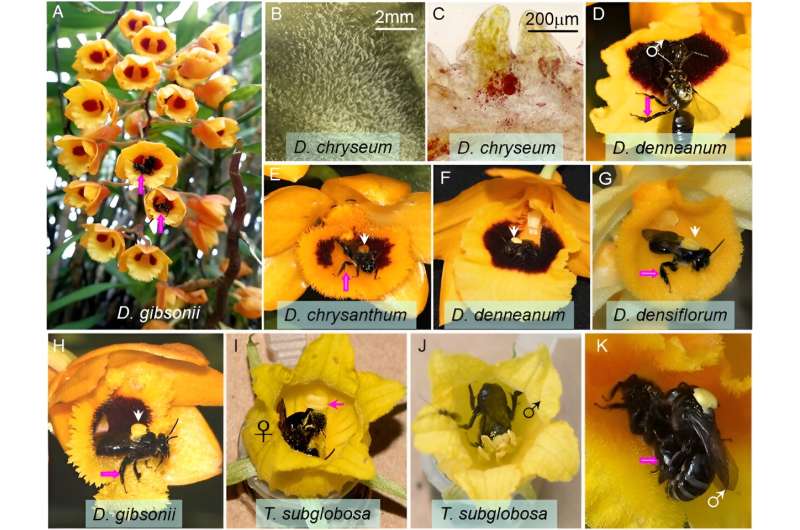This article has been reviewed according to Science X's editorial process and policies. Editors have highlighted the following attributes while ensuring the content's credibility:
fact-checked
trusted source
proofread
A new oil flower/oil bee pollination mutualism involving male-bee-pollinated orchids discovered in tropical Asia

It is well known that animal-pollinated plants usually offer nectar or pollen to reward vectors for pollen transfer. While nectar is a kind of sugar water, pollen is protein-rich, a must-need nutrient for bee babies. The honey humans consume is made by female bee workers. Fifty years ago, German scientist Stefan Vogel first identified that droplets are non-water miscible 'nectar' but lipids in some flowering plants, discovering the so-called oil-flower, which offers oil as a reward for female bees.
The oil bees collect fat droplets with special setae or abdominal hairs and then mix them with pollen as larval food or use the oil for nest lining. Worldwide, oil rewards are offered by about 150 genera in 11 families whose flowers are exploited by 370 species of oil-collecting bees.
To date, our understanding of the ecology and evolution of the oil-bee and oil-flower interactions are mostly from studies in South America and South Africa, although in Asia, since the Early Eocene oil-offering flowers in Cucurbitaceae have coevolved with Ctenoplectra bees whose females have unique setae and behaviors for oil mopping.
In research published in the journal National Science Review, a team found that the fatty oil in the minute hairs on the labella, the lower lip of corolla, appeared in 33 of 41 species sampled in Dendrobium and Galeola, two orchid genera, providing the first document of oil-offering orchid flowers in Asia. Surprisingly, these orchids are majorly exploited by male bees of Ctenoplectra, not females, over a 6-year field study in Xishuangbanna and Malipo, southern Yunnan Province.
As predicted, female bees prefer visiting oil-flowers in Cucurbitaceae to collect oil, nectar, and pollen. The observation of males collecting floral oil from orchids has not been reported before. In this report, male Ctenoplectra cornuta was observed as the sole effective pollinator for 12 Dendrobium and one Galeola orchid species.
The discovery that many orchid species offer oil and are pollinated by male Ctenoplectra cornuta, the females of which depend on Cucurbitaceae oil and pollen, illustrates multipartite oil-flower/oil-bee pollination mutualisms. When Dendrobium inflorescences were set out in the field with cucurbit oil flowers nearby, oil-bee visit frequencies (visits per flower per hour) to the orchid flowers increased hundreds of times, suggesting that the orchids' pollination success was greatly attributed to the co-flowering of Cucurbitaceae species.
The Dendrobium genus is species-rich (1500 species), but the most economically important orchids have declined in tropical Asia in the last two decades. Given that their reproductive success extremely depends on the male oil bees, this finding also highlights the challenge of maintaining or restoring natural orchid populations.
More information: Meng Zhang et al, Multipartite oil-flower/oil-bee mutualisms involving male-bee-pollinated orchids in tropical Asia, National Science Review (2024). DOI: 10.1093/nsr/nwae072
Provided by Science China Press




















